zur deutschen Version, Flagge klicken oder tippen

- Syrian Arab Republic (Syria)
- presidial republic
- own name: Al-Jomhouriya al-Arabiya as-Suriya
• Flags
• Other Flags
• Historical Flags
• Meaning/Origin of the Flag
• Coat of Arms
• Meaning/Origin of the Coat of Arms
• Aircraft Roundel
• Map
• Numbers and Facts
• History
• Origin of the Country's Name
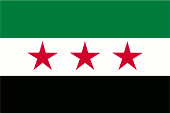
since December 2024,
National, state, merchant and naval flag,
ratio = 2:3,
Source, by: Wikipedia (DE)





2025,
flag of Military Council for the Liberation of Syria,
ratio = 2:3,
Source, by: Volker Preuß





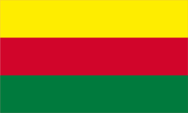
since 17th of March in 2016, Rojava,
Flag of the autonomous Kurdish region of Rojava in Northern Syria,
Source, by: Wikipedia (DE)



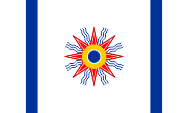
Flag of the Chaldeans
(Christians of the Chaldean Catholic Church),
ratio = 2:3,
Source, by: Flags of the World



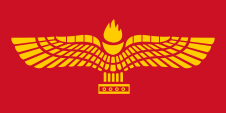
Flag of the Arameans,
ratio = 1:2 (2:3),
Source, by: Flags of the World




Flag of the Assyrians,
ratio = 7:10,
Source, by: Flags of the World




Flag of Druze,
ratio = 2:3,
Source, by: Wikipedia (DE)




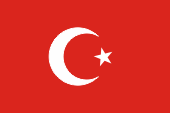
to 1918,
Flag of the Ottoman Empire,
Source, by: Flags of the World




1918–1920,
Flag of the Arab Uprising,
Source, by: Die Welt der Flaggen



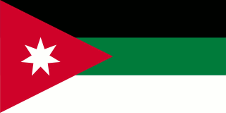
1920 (March–July),
Flag of the Kingdom of Syria,
ratio = 1:2,
Source, by: Flags of the World




1920 (July–Aug.),
Syria under French Mandate,
ratio = 2:3,
Source, by: Flags of the World



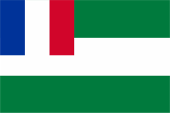
1922–1932,
National flag,
ratio = 2:3,
Source, by: Flags of the World




1932–1958, 1961–1963,
National flag,
ratio = 2:3 (1:2),
Source, by: Flags of the World




1958–1961,
National flag,
ratio = 2:3,
Source, by: Flags of the World



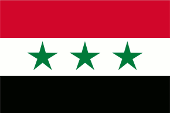
1963–1972,
National flag,
ratio = 2:3,
Source, by: Flags of the World



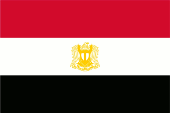
1972–1980,
National flag,
ratio = 2:3,
Source, by: Flags of the World




1980–2024,
National, state, merchant and naval flag,
ratio = 2:3,
Source, by: Flags of the World





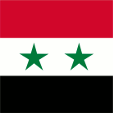
1980–2024,
Flag of the President,
ratio = 1:1,
Source, by: Flags of the World



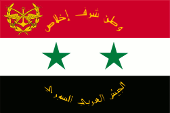
1980(?)–2024,
Flag of the Armed Forces,
ratio = 2:3,
Source, by: Flags of the World



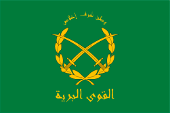
1980(?)–2024,
Flag of the Army,
ratio = 2:3,
Source, by: Flags of the World



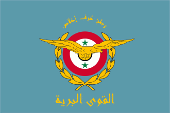
1980(?)–2024,
Flag of the Air Force,
ratio = 2:3,
Source, by: Flags of the World



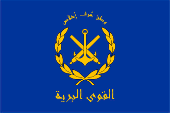
1980(?)–2024,
Flag of the Navy,
ratio = 2:3,
Source, by: Flags of the World



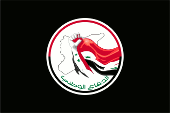
2012–2024,
Flag of the National Defence Force,
ratio = 2:3,
Source, by: Flags of the World




1966–2024,
Flag of the Baath Party,
ratio = 2:3,
Source, by: Flags of the World




The flag of Syria, which was reintroduced on 10th of December 2024, shows three horizontal stripes in green, white and black, as well as three five-pointed red stars in the centre of the white stripe. The three stars originally stood for the three former Ottoman provinces of Damascus, Aleppo and Deir az-Zor, from which Syria was formed after the First World War. The flag had already been introduced in 1932 and was retained until 1958, when the country joined the United Arab Republic (VAR) in 1958 and the common flag in red, white and black was then used. It was used again from 1961 to 1963. The colours of the flag are the Pan-Arab colours (see below) and refer to the flag of the Arab Revolt, which was introduced by the Hashemites from Hejaz in 1918. The colours are also given the following meaning today: Red stands for the blood spilled to achieve the goals in the struggle, white symbolises the bright future, black stands for the years of oppression and green is the colour of the Prophet Mohammed and Islam. The previously used flag of Syria was introduced on 29th of March in 1980, having already been in use between 1958 and 1961. It showed three horizontal stripes in red, white and black, as well as two five-pointed green stars in the centre of the white stripe. The colour triad of red, white and black is also sometimes referred to here as the Pan-Arabic colours. This is not entirely correct. The three colours go back to Gamal Abd el-Nasser, Egyptian officer, politician and later president and prime minister (1918-1970), the most important representative of Arab nationalism and pan-Arabism. After the national revolution of 1952, the Arab Liberation Flag was introduced in Egypt, representing these ideals. It became a model for many other Arab states and confederations, at least in its choice and arrangement. The colours always stand for the revolution (red), the future (white) and the past (black). Nevertheless, the colours red, white and black go back to the flag of the Arab Revolt during the First World War. However, the colours of the Arab Revolt (Arab Movement) also include green. The first flag of Syria dates back to 1920, when there was a brief Kingdom of Syria. Its flag was the flag of the Arab Uprising, but the red triangle on the mast also showed a white, seven-pointed star. Afterwards, what is now Syria and Lebanon came under the French mandate of the League of Nations. A light blue flag with a crescent and the French tricolor in the upper corner was adopted for the area in 1920. But after just a few months, the mandate was divided ethnically and religiously into different areas, each with their own different flags, but nearly all with the French tricolor in the top corner. These were: 1) Alawite State of Latakia (1920–1936), 2) State of Aleppo (1920–1924), 3) State of Damascus (1920–1922), 4) State of Greater Lebanon (1920–1943), 5) Druze State of Souaida (1921–1932). These areas were gradually brought back under common administration, the Syrian Federation, founded in 1922. Its flag featured three horizontal stripes of green, white and green and the French tricolor in the upper corner. The state of Syria emerged from this federation in 1925, which probably retained the green-white-green flag until 1932. A new flag was introduced on 1st of January in 1932. It featured three horizontal stripes of green, white and black, as well as three five-pointed red stars in the middle of the white stripe. The colors of this flag are the Pan-Arab Colors (see below) and refer to the flag of the Arab Uprising introduced by the Hashemites from Hejaz in 1918. The three stars stood for the three former Ottoman provinces of Damascus, Aleppo and Deir az-Zor, from which Syria was formed after the First World War. The flag remained in use in Syria until the country joined the United Arab Republic (UAR) in 1958 and the common flag was used. This flag showed three horizontal stripes of red, white and black, as well as two five-pointed green stars (Syria and Egypt) in the middle of the white stripe. After Syria left the UAR in 1961, the previous flag was reintroduced. On 8th of March in 1963, a new flag was introduced that was similar to the UAR flag. It featured three horizontal stripes of red, white and black, as well as three five-pointed green stars in the middle of the white stripe. The three stars on this flag symbolized a proposed union with Egypt and Iraq. This flag was also introduced in Iraq and has in principle been retained to 2008. In 1971, President Hafiz al Assad came to power in Syria and in 1972 a new flag was introduced once more. The three stars were removed and replaced with a golden version of the national coat of arms. The UAR flag was reintroduced on 29th of March in 1980 and has been retained to this day. The two stars now represent the hope of once again forming a strong alliance with Egypt.
The Pan-Arabian Colors: The four colours of green, white, black and red are a special Arabic colour symbol, the Pan-Arabic colours. These colours were officially introduced as the colours of the Arab Movement during the First World War, when the Kingdom of Hejaz broke away from the Ottoman Empire, by Sheikh Hussein of Mecca – from the Hashemid dynasty. The flag of the Hejaz served as a model. The colours have the following meanings: red is the colour of Omar, the second caliph; white stands for the Umayyads, a dynasty of caliphs that goes back to the fifth caliph Moawiya I.; green stands for the Fatimids, an Ismaili-Shiite dynasty of caliphs that goes back to the fourth caliph Ali; and black stands for the Abbasids, a dynasty of caliphs that goes back to the caliph Abbas I. Red is also the colour of the Hashemids, an Arab ruling dynasty that probably goes back to Hashem ibn Abd al-Manaf, the grandfather of Muhammad.
Source:
Flags of the World,
Die Welt der Flaggen,
Flaggen Wappen Hymnen,
Wikipedia (DE),
Volker Preuß


since July 2025,
Coat of arms of Syria,
Source: Suriye Arap Cumhuriyeti, CC BY-SA 4.0, via Wikimedia Commons

December 2024 to July 2025,
Coat of arms of Syria,
Source: See page for author, Public domain, via Wikimedia Commons
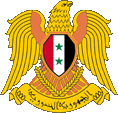
1980–2024,
Coat of arms of Syria,
Source: Corel Draw 4
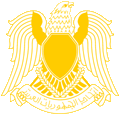
1972–1980,
Coat of arms of Syria,
Source: Corel Draw 4

The current national coat of arms of Syria was introduced on 3rd of July in 2025, a break in style from the previous coat of arms, which was adopted as the country's coat of arms in its basic form already in 1932 and has been slightly modified ever since, depending on the political course. Then as now, the coat of arms shows a golden falcon, now only as a two-dimensional silhouette. The golden falcon is the emblem of the Kuraish tribe from which the Prophet Mohammed descended. The falcon is devoid of any decorative accessories, apart from the three stars known from the flag, which appear above the falcon's head. They were certainly taken from the flag, but originally stood for the three former Ottoman provinces of Damascus, Aleppo and Deir az-Zor, from which Syria was formed after the First World War. Until 2025, the falcon displayed a shield on its chest, usually designed corresponding to the flag in force at the time. The ribbon below always bore the name of the country. Only during the period of the United Arab Republic (1958–1961) a different coat of arms was used, which was similar but showed the eagle of Saladin.
Source:
Wikipedia (DE),
Die Welt der Flaggen,
Flaggen Wappen Hymnen,
Volker Preuß

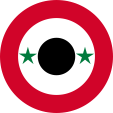
1972–2024,
Aircraft Roundel,
Source, by: Wikipedia (EN)
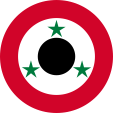
1963–1972,
Aircraft Roundel,
Source, by: Wikipedia (EN)

1948–1958,
Aircraft Roundel,
Source, by: Wikipedia (EN)

Location:
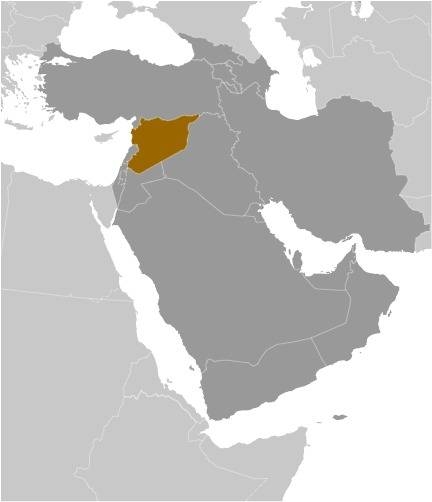
Source: CIA World Factbook
Map of the country:
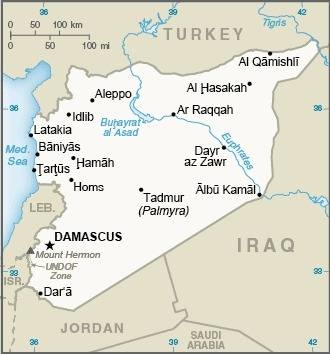
Source: CIA World Factbook

Area: 71.498 square miles
Inhabitants: 22.100.000 (2022), thereof 89 % Arabs, 9 % Kurds, 1 % Armenians, Circassians, Turkomans, Turks
Religions: 74 % Sunni Muslims, 12 % Alawites, 10 % Christian, 2 % Shia Muslims, 2 % Druze
Density of Population: 309 inh./sq.mi.
Capital: Damaskus (arab. Dimashq), 1.834.741 inh. (2010)
official Language: Arabic
other Languages: Syrian Arabic, Curdish Languages, Armenian, Syrian, Turkoman, Circassian, French, English, Russian
Currency: 1 Syrian Lira / Pound (SYP, £S, syr£) = 100 Piastres (Qurusch)
Time Zone: GMT + 3 h
Source:
Wikipedia (D)

4th millenary B.C. · settlement by Kanaanitans and Hurrits
2nd millenary B.C. · settlement by Arameans
end of 2nd millenary B.C. · part of Assyria
539 B.C. · to Persia
333 B.C. · to the Empire of Alexander the Great
300 B.C. · center of the Empire of the Seleukids
63 B.C. · to the Roman Empire
395 A.D. · to the East Roman Empire (Byzantium)
635–637 · conquest by the Arabs, Islamization
ca. 945–1000 · to the Empire of the Hamdanids
1076 · conquest by the Selchuks, later to the Empire of the Fatimids (Egypt)
1099–1291 · partial under the rule of the crusaders (Principality of Antiochia, County Tripolis, Kingdom of Yerusalem)
1303–1260 · part of the Empire of the Mongols
1260 · conquest by the Mamluks (Egypt)
1516–1918 · part of the Ottoman Empire (Turkey)
1914–1918 · First World War, conquest by British and Arabian troops in the year 1918
1919 · withdrawal of the British troops, occupation by French troops
1920 · proclamation of the Hashemit Kingdom of Syria by Faisal I., subjection by French troops, Syria becomes a French mandate territory of the League of Nations
1926 · excorporation of Libanon as an own republic
1936 · planed independence is not granted
1939 · ceding of Alexandrette (Iskenderun) to the Turkey
1939–1945 · Second World War, British and "free" French troops occupy the country in 1941
1941 · formal independence
17th of April 1946 · withdrawal of the French troops, full independence from France
1958 · union with Egypt to the United Arabian Republic (UAR)
1961 · military coup d’état, end of the United Arabian Republic
1963 · elections, the Baath Party comes to the power
1967 · Six Days War against Israel, Israel occupies the Syrian Golan Heights
1970 · takeover by General Hafiz al-Assad
1973 · new constitution, democratic, socialistic, sovereign people's state
October 1973 · attack of Syria and Egypt against Israel, Israeli troops invade Syria partially
1976 · intervention of Syria in the Lebanese civil war, Syrian troops occupy large parts of Lebanon
1991 · 2nd Gulf War, Syria supports the USA
10th of June 2000 · death of Hafiz al-Assad
10th of July 2000 · Bashar al-Assad, the son von Hafiz al-Assad, becomes elected to president
2005 · the Syrian troops leave Lebanon
since 2011 · civil war (initially in 2011 radical Islamic protests, from 2012 invasion of the Islamic State, from 2014 recaptures by the Syrian government and Kurds, including Kurdish expansion, from 2015 invasion by Turkey in the north, the Syrian government asks Russia for help, the Islamic State is destroyed, the Kurds occupy the conquered areas or administer them together with the Syrian government, the radical Islamic forces are isolated in the northwest (Idlib), Turkey occupies areas in the north)
17th of March in 2016 · the Kurds proclaim in Northern Syria the Autonomous Region of "Rojava" (Syrian Kurdistan, West Kurdistan)
November/December 2024 · radical islamist Syrian rebels under Ahmed al-Sharaa launch a major offensive from the Idlib region and occupy almost the entire country within a few days, on 7th of December in 2024, President Assad leaves Syria for Russia before the capture of Damascus
March 2025 · formation of the armed resistance in the Latakia region under the "Military Council for the Liberation of Syria" against the country's radical Islamist leadership
Source:
Atlas zur Geschichte,
Wikipedia (D),
Discovery '97,
Weltgeschichte,
Volker Preuß


President Assad and his wife

Ruler Sharaa and his wife
The name "Syria" has old Greek roots, as the area of the today’s Syria belonged to Assyria (State of Assur). Assyria is in Assyrian language "Ashshur", possibly a hint to the Arabian name of that geographic region "Bilad Ash-Sham".
Source: Volker Preuß


![]()





































![]()
![]()
